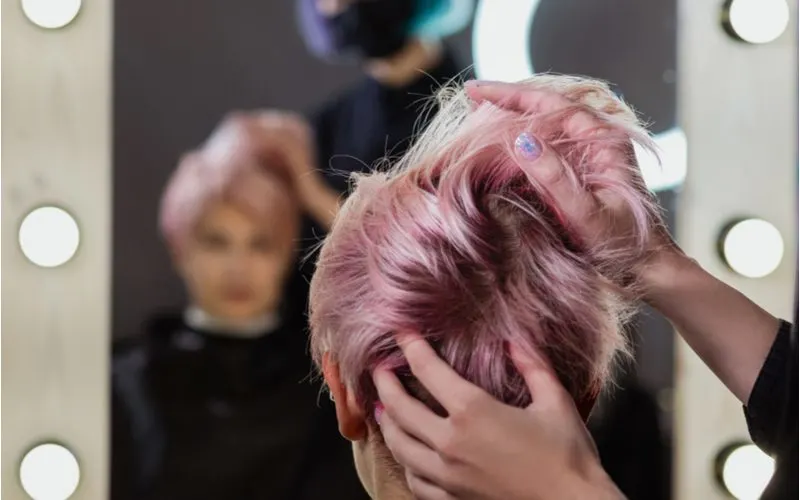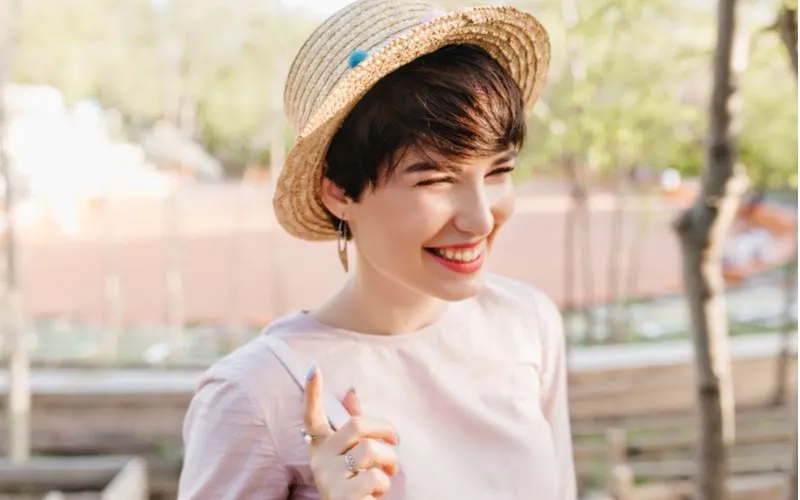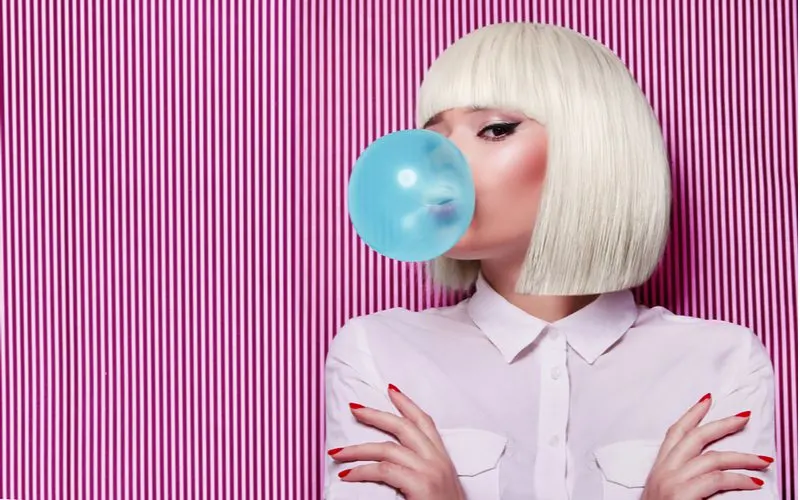Jump to:
You’ve rocked a pixie cut, and now you want to grow it out into a longer, different cut. Luckily, this guide has you covered for how to grow out a pixie cut, plus helpful tips on hair care and reaching your growth goals, and fast.
How to Grow Out a Pixie: A Summary
Growing out a pixie cut is going to take both time and patience. Depending on the length and hairstyle you want, you might need extra steps and supplies, but patience is still the biggest key.
Expect to follow the below steps:
- Get ready for the bad first 3 months
- Keep up with regular trims
- Part your hair or bangs in different ways
- Use hats, styling gels, bobby pins, dryers
- Experiment when your pixie becomes a bob cut
- Have fun with wigs, if you like
- Don’t forget your shampoo, oil, and conditioning treatments
As long as you have plenty of styling gel, bobby pins, and maybe a hairdryer, you’ve got a good arsenal of styles to keep you looking good while your pixie is growing.
How to Grow Out a Pixie in 7 Steps
It takes roughly 9 months to a year for a pixie cut to grow out. In that time, you can take specific steps to tame your hair as it grows into the style you want next.
Step 1: Get Ready for the Bad First Three Months
How your pixie cut grows out depends on how your stylist initially cut and even how your hair grows. This probably doesn’t sound helpful, but every person’s hair grows at different rates, so every cut will look different, especially during the first three months.
During this time, your hair will lose its initial style, and it may be frustrating to watch that style grow out in funny ways. That’s where you can get creative with restyling it, though.
If you do trim your hair, again, keep the back nice and tidy while your top and front hair steadily grows out. Doing so will save you a little trouble when styling while at the same time give you a little freedom when styling your front hair, whether you want to style it as bangs or not.
Step 2: Keep Up with Regular Trims

Spaskov/Shutterstock
Some people decide not to trim their hair as it grows out. It’s a perfectly legit way to grow out a pixie cut, but it takes a little more creativity to hide uneven hair. If you decide to trim your hair, it’s best to do it regularly: every 2 to 3 months. Keep a particular watch on the back of your head since it could soon look like a mullet.
Luckily, you can rest assured that a pixie cut doesn’t require much maintenance day to day. You will just have to monitor how your hair is growing out, tweak with a trim if necessary, and look for unique, flattering ways to style your hair at different lengths in between trims.
One rule of thumb is that the least damaged hair on your head will grow the fastest. Different parts of your hair will grow at various rates, so you’ll finally see how fast your hair grows.
Step 3: Part Your Hair or Bangs in Different Ways
Parting your hair is one of the simplest ways to cover up uneven hair or change things up a bit. If you part your hair off to one side, you can try the other side. Even just trying a middle part can do a lot for your look. Experiment with wearing your bangs in different ways too.
You might have some days where your hair won’t cooperate very well, but keep trying and don’t give up. You might consider pulling your side bangs forward and pushing the rest back with styling gel, barrettes, or a headband. For a little extra fun, consider dying your side bangs a fun color.
Step 4: Use Hats, Styling Gel, Bobby Pins, and Blow Dryers

Look Studio/Shutterstock
Hats and styling gel are two distinct strategies for controlling your hair while growing out a pixie cut. Hats look sophisticated with any style, but they also cover up awkward and ugly growing stages.
Some people prefer taming their whole head with styling gel. You can spread it throughout your entire head to make your hair appear wet while helping the hair stay close to your head. If you like a little more volume, dry your hair at the root with a blow dryer. Blow dryers and hair gel together are a big help when trying to create volume. Pixie cuts tend to look slightly trendier when they’re shaggier and don’t lie flat on your head.
You might also try using bobby pins to strategically pull certain parts back or keep others close to your head. If you want to create volume, you can twist different sections of hair toward or up the back of your head before pinning them down.
For extra effect, you can leave a few sections or wisps of hair down around your ears. For an extra fancy pixie updo, you can twist sections around your head using fancy accessories. Jeweled barrettes, headbands, or clips can add a lot of sparkle to an otherwise simple hairdo.
Consider putting a little texturizing mousse into your hair and scrunch it up. The look covers any uneven strands and gives off an intentionally messy look. Just rub a quarter-size amount into your hands, rub it into your hands, and then run your fingers in every direction, tousling your hair.
Step 5: Experiment More When The Pixie Becomes a Bob Cut
At around the 7 to 8 month mark, your pixie cut may become a bob cut. At this point, it will be around jaw-length or above the shoulders. Headbands come in handy for creating volume and adding color at this stage.
You can blow dry your hair to make a little more volume at the front and then cap it with a headband. Similarly, you can use a headband that wraps around your head and tuck some bits of hair over the bottom of the band.
Your hair is now also long enough to curl or apply waves to. If you’re into more old-fashioned cuts, you can put clips into your slightly damp hair to create a 1920s flapper wave. You might even ask your stylist to cut it into an inverted bob, where the back is slightly shorter than the front.
If your hair is a touch longer, you can put it into small curls. You can try to make little ringlets for a springier, more youthful look, or you can just curl the hair inward toward your scalp.
If you want to use a curling iron, I suggest a 1/4 inch or a 1/2 inch curling iron. You might find it helpful to use these two different barrel sizes on other parts of your hair for a less uniform look. You should also use a thermal protectant spray to help protect your hair from excess heat and help your curls stay in longer.
It might be difficult at first, but you can also braid your longer lengths into a Dutch or French Braid on any part of your head. Whether you braid down the middle or to one side, it does wonder for keeping flyaways out of your face.
Or, just to keep things simple, you can pull all your hair back into a ponytail. Feel free to add some cute bobby pins or barrettes to your hair to keep the style looking cute and fun. A scrunchie is a nice throwback way of keeping your hair out of your face too.
Read Next: How to Curl Really Short Hair
Step 6: Have Fun With Wigs, If You Like

Ekaterina Jurkova/Shutterstock
It might sound strange, but if you have the money to invest in one or two high-quality wigs, these can help you through your absolute worst days. You’d simply have to put a wig cap over your natural hair to flatten it to your head and attach the wig tightly around your head.
You might want to use hair extensions if you find wigs uncomfortable. Bear in mind that wigs require extra tools to keep them in good condition. You’re going to need a brush or comb meant for wigs, and you’ll need a wig head to store them on.
You can find wigs at several reputable sources online, including Amazon, for affordable options. As long as you brush or comb them often and store them on a wig head at room temperature, they’ll last a long time.
Step 7: Don’t Forget Your Shampoo, Conditioning, and Oiling Treatments
Now is the time to cherish and nourish your hair, so you will want to keep up with all regular hygiene and maintenance through regular shampooing, conditioning, and deep-conditioning treatments. Make sure that all of your products to contain moisturizers and healthy ingredients designed to help your hair grow and look its best.
As you probably know, Conditioner is supposed to keep your hair looking pretty and shiny, but it also protects it from pollutants or dirt. This is ideal because you don’t want to shampoo your hair any more than it necessary while growing it out. While it’s tempting to shampoo every single day, you may want to only shampoo every couple of days, as shampooing too often can dry your hair out. You want natural oils to spread through your hair to keep it healthy, and shampooing too much prevents that.
Oil treatments also stimulate hair growth before you shampoo and condition. You want to leave some oil on your scalp for roughly 10 minutes before you shampoo it out. Look for hair oils that mostly contain unrefined coconut oil, with a dash of almond oil and macadamia oil.
Things to Consider

Spaskov/Shutterstock
Every person’s journey to growing out their pixie cut will be different. In case you need a little extra help in that journey, here are some things to remember:
- You’ll have both good and bad days trying to style a growing-out pixie cut, so have patience and don’t stress too much.
- If you’re growing out thick or curly hair, growing out a pixie cut may take a bit longer.
- Keep up with a high-protein diet. Hair contains protein, so feeding your body more may encourage hair growth.
- Drink plenty of water. As long as your body is hydrated, so is your hair.
- Use thermal protectant spray before using all heat products. Too much heat every day in your hair may dry it out, even with conditioning treatments.
- Feel free to use hairspray if you want to keep your look all day. For curlier, thicker hair, mousse will work a little better than just hairspray.
- If you don’t want to create volume with a hairdryer (which introduces heat to your hair), use dry shampoo. It’ll not only keep your hair from looking oily, but it’ll poof your hair up slightly.
So, How Do You Grow Out a Pixie Cut?
The only real secret to growing out a pixie cut is to have patience and get creative with covering up uneven hair. Make sure you keep up with regular trimming and have a hefty supply of styling gel and bobby pins on hand.
Plus, if you have a bad hair day, don’t worry: you can always find a fun way to style your hair, whether with a hat, headband, or even a wig.
